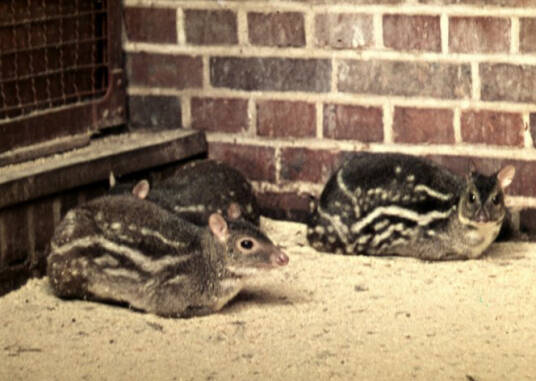Moschiola indica
IUCN
LCBasic Information
Scientific classification
- name:Moschiola indica
- Scientific Name:Moschiola indica,Indian Chevrotain、Indian Mouse Deer、Indian Mousedeer、Indian Spotted Chevrotain
- Outline:Ungulata
- Family:Artiodactylus Tragopanidae Tragopanidae
Vital signs
- length:48-60cm
- Weight:3-5.45kg
- lifetime:8-12years
Feature
The back is medium to dark brown, the belly is white, and there are four or five light vertical stripes or spots on the back.
Distribution and Habitat
The Indian spotted chevrotain is found in most of India, from the southernmost states of Tamil Nadu and Kerala, northwards to at least 24°N, i.e. near Mandla, Hoshangabad, Paramao and Udaipur (Rajasthan), 24°04'N. Uncertainty exists in Nepal.
Inhabits a variety of forest habitats in southern India and Nepal, up to 1,850 m above sea level. Most common in tropical deciduous forests, but also found in dry thorn forests, semi-evergreen forests and moist evergreen forests. Prefers habitats near water, less deciduous leaves and where bamboo thickets are present.
Appearance
The Indian spotted chevrotain has a head-body length of 48-60 cm, shoulder height of 25-33 cm, and a tail length of 3-6 cm; the average weight is 3 kg, but the maximum weight has been reported to be up to 5.45 kg. It is the largest member of the genus spotted chevrotain. The species has short forelimbs, long hind limbs, and four-toed feet. The back is arched. It looks like a deer rather than a deer, with no horns, a pointed and narrow snout, and large eyes. The nostrils are slit-like, there are no facial glands and foot glands, and the feet are long and thin, with 4 toes on each foot. It chews the cud, and the stomach is divided into 3 chambers, with the third chamber degenerate.
The fur color is medium to dark brown on the back and pale underparts. There are 4-5 light longitudinal stripes or loosely arranged white spots on the sides of the body. 3 white broken bands cross the buttocks. The individual spot patterns (occasionally merged together to form short longitudinal stripes) ar
Details
Indian Chevrotain (scientific name: Moschiola indica) is also known as Indian Chevrotain, Indian Mouse Deer, Indian Mousedeer, Indian Spotted Chevrotain. It has no subspecies and is the largest member of the genus Moschiola.

The Indian spotted chevrotain is a shy and secretive species. Like other forest ruminants, adults are usually solitary except when courting, sometimes appearing in pairs. The species is mainly crepuscular and nocturnal. It often crosses narrow paths through dense bushes. During the day, they seek shelter in tree holes, bushes, and rock crevices. They are also reported to be able to climb up leaning tree trunks and occasionally, may rest in the leaf litter on the forest floor. Their mottled fur serves as an effective camouflage as long as they remain motionless. When they sense danger, they usually stand still, only to suddenly dash into the forest thickets or a carefully chosen hiding spot when danger approaches them. They forage for herbs and shrubs and fallen fruit from the forest floor. They feed on fallen fruit and also eat leaves and shoots.
The natural enemies of the Indian spotted chevrotain are tigers, leopards and small cats, wild dogs, martens, eagles, owls, pythons and crocodiles.
The Indian spotted chevrotain breeds throughout the year, but birth rates are higher from September to February (the period after the monsoon season). Mating occurs when the female lies down. Females mate only once per estrus cycle. The gestation period is 154 days. The litter size is one, with twins occasionally. The average weight of the young at birth is 470 grams. Like other chevrotains of the same genus, females return to estrus within 4-6 hours after giving birth. Females reach sexual maturity at 5-5.5 months.
The estimated density of the Indian chevrotain in the Periyar Tiger Reserve is 21.4 individuals per square kilometer.
Listed in the IUCN Red List of Threatened Species in 2016 ver3.1 - Least Concern (LC).
Protect wild animals and stop eating game.
Maintaining ecological balance is everyone's responsibility!








